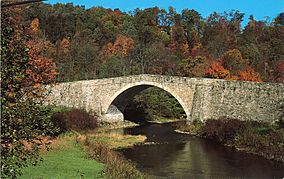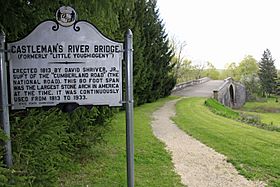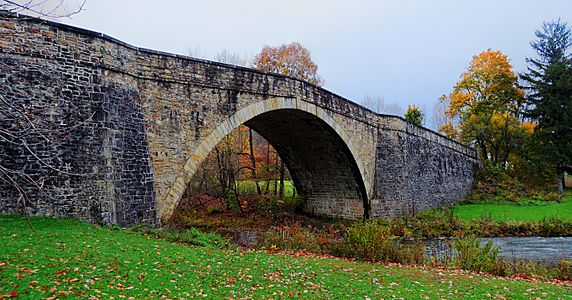Casselman Bridge facts for kids
Quick facts for kids Casselman River Bridge State Park |
|
|---|---|

The bridge's south aspect
|
|
| Location | Garrett County, Maryland, United States |
| Nearest town | Grantsville, Maryland |
| Area | 4 acres (1.6 ha) |
| Elevation | 2,113 ft (644 m) |
| Designation | Maryland state park |
| Established | 1957 |
| Administrator | Maryland Department of Natural Resources |
| Website | Casselman River Bridge State Park |
|
Casselman's Bridge, National Road
|
|
 |
|
| Location | East of Grantsville on U.S. Route 40 Alternate, Grantsville, Maryland |
| Area | < 1 acre |
| Built | 1813-1814 |
| Architect | David Shriver, Jr. |
| NRHP reference No. | 66000391 |
| Significant dates | |
| Added to NRHP | October 15, 1966 |
| Designated NHL | January 29, 1964 |
The Casselman Bridge is a very old and important stone bridge in Maryland. It is located near Grantsville in Garrett County. This bridge was built a long time ago, between 1813 and 1814. It was an important part of the National Road, which was one of the first major highways in the United States.
The National Road helped people travel west across the country. When it was built, the Casselman Bridge had the largest stone arch in all of America! It was used for cars and wagons for many years, from 1813 until 1933. Today, the bridge is part of the Casselman River Bridge State Park. It is protected by the state of Maryland. In 1964, it was named a National Historic Landmark, which means it's a very special historic place.
Contents
History of the Casselman Bridge
The Casselman Bridge is a stone arch bridge that is about 354-foot-long (108 m). Its main arch spans 80 feet (24 m) and is 30-foot-high (9.1 m). The road on top of the bridge is about 48 feet (15 m) wide.
Building the Bridge for Westward Travel
The bridge was built to help people move west. In the early 1800s, many people wanted to settle new lands. The National Road made it easier to travel through the wilderness west of Cumberland, Maryland. The first wagons and carts crossed the bridge in 1815.
As more and more people moved west, the Casselman Bridge became very busy. Large wagons pulled by 12 horses would cross it. These wagons could carry very heavy loads, sometimes up to 10 tons! A small part of the original National Road can still be seen near the bridge today.
Bridge Upgrades and Preservation Efforts
In 1911, the bridge was made stronger so that cars and trucks could use it. It continued to be an important highway until 1933. That year, a new steel bridge was built nearby for what is now US Route 40 Alternate.
After 1933, people realized the old stone bridge needed protection. In the 1940s and early 1950s, parts of the bridge started to crumble. So, efforts were made to save it. The bridge was closed to vehicles in 1953. The state of Maryland helped restore it in the mid-1950s. More repairs and care happened in 1979, 1996, 2002, and 2012 to keep this historic landmark safe.
Activities at Casselman River Bridge State Park
Casselman River Bridge State Park is a great place to visit. You can walk across the historic bridge and imagine what it was like for travelers long ago.
Things to Do and See
The park has nice areas for picnicking, where you can enjoy a meal outdoors. You can also go fishing in the Casselman River, which flows under the bridge.
Near the park, there are other interesting historic places to explore. You can visit Stanton's Mill, which is an old mill listed on the National Register of Historic Places. There are also restored log cabins at the Spruce Forest Artisan Village. These cabins are now craft shops where you can see local artists at work.



